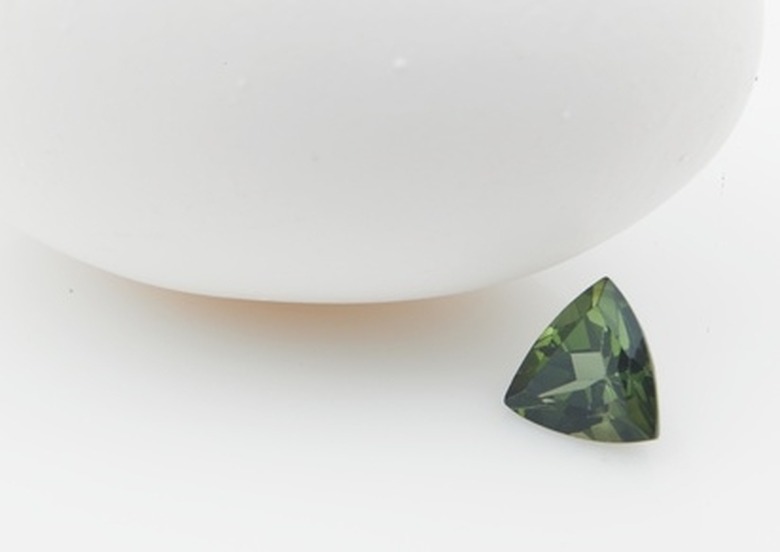How To Identify Green Semiprecious Stones
The wide variety of green semiprecious gems may make it difficult to identify a particular stone at first glance. However, knowing different classifications for stones can help you to identify it. Often you can classify a stone by observation, without using scientific equipment or tests. Record all the observations you make to compare against the classifications in your gem book. If a stone appears similar to two different varieties of green semiprecious stones, you can continue testing or have a professional gemologist evaluate it.
Step 1
Clean the stone of any dirt or debris with water and a soft cloth. You need to be able to see the stone clearly to determine what it is.
Step 2
Place the stone under a light and determine its transparency. If you can see clear through the stone, it is transparent. If you can't see through the stone at all, it is opaque. If you can see through the stone but the image is cloudy, it is translucent. Just to name a few of the green semiprecious varieties: dioptase, atacamite, variscite, olivine and peridot stones are transparent to translucent. Malachite, on the other hand, will be translucent to opaque. Tourmaline can be transparent, translucent or opaque.
Step 3
While the stone is under the light, compare the color of the stone to shades of green on the color wheel. Dioptase is emerald to greenish blue. Atacamite ranges from bright green to dark green, while malachite is usually a rich green. Olivine and peridot range from green to yellow green. Tourmaline can display any of these shades. It may also appear as green at one end and pink at the other; this is known as watermelon tourmaline.
Step 4
Conduct a streak test. Rub the stone against a piece of paper on a hard surface. The color of the powder that results will help you determine the true color of the stone. Malachite has a pale green streak, while olivine, tourmaline and peridot have a colorless streak. Dioptase's streak is a pale greenish blue and atacamite has an apple green streak.
Step 5
Determine the luster of the stone under the light. It may be vitreous, reflecting the light like glass; metallic, shining like a piece of metal; or dull, showing no luster at all. Dioptase, atacamite, malachite, olivine, peridot and tourmaline all have a vitreous luster. However, variscite has a vitreous to dull luster.
Step 6
If you found the stone yourself, record the location where you found it. If it was in its natural location, this information can help you eliminate possibilities. Malachite exists in nine countries, dioptase in seven countries and peridot and olivine in six.
Step 7
Estimate the hardness of the stone on the Mohs scale. You can do this by using an everyday object with a known hardness. Coins have a hardness of 3.5, glass a hardness of 6 and a knife blade a hardness of 5.5. Quartz has a hardness of 7; you can use it to test other stones. Test for hardness by attempting to scratch the stone with one of these objects. Malachite has a hardness of 3.5 to 4; variscite has a hardness of 3.5 to 4.5; peridot and olivine have a hardness of 6.5; dioptase has a hardness of 5; atacamite has a hardness of 3 to 3.5; tourmaline has a hardness of 7 to 7.5.
Step 8
Compare the information you have recorded with information listed in your gem books. If the properties of your stone match those of a stone in the books, you can make a positive identification.
Things Needed
- Gemstone book
- Magnifying glass
- Color wheel
TL;DR (Too Long; Didn't Read)
It's a good idea to use more than one gemstone book. Different books have slightly differing information about the exact appearance of stones; this can help you better determine what stone you have.
References
- "Gems of the World"; Cally Oldershaw; 2008.
- "Smithsonian Handbook: Rocks and Minerals"; Chris Pellant; 2002.
Cite This Article
MLA
Wall, Kelly. "How To Identify Green Semiprecious Stones" sciencing.com, https://www.sciencing.com/identify-green-semiprecious-stones-8376613/. 24 April 2017.
APA
Wall, Kelly. (2017, April 24). How To Identify Green Semiprecious Stones. sciencing.com. Retrieved from https://www.sciencing.com/identify-green-semiprecious-stones-8376613/
Chicago
Wall, Kelly. How To Identify Green Semiprecious Stones last modified March 24, 2022. https://www.sciencing.com/identify-green-semiprecious-stones-8376613/
